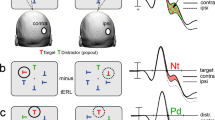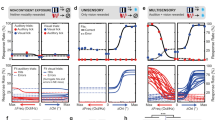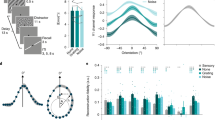Abstract
Finding sought visual targets requires our brains to flexibly combine working memory information about what we are looking for with visual information about what we are looking at. To investigate the neural computations involved in finding visual targets, we recorded neural responses in inferotemporal cortex (IT) and perirhinal cortex (PRH) as macaque monkeys performed a task that required them to find targets in sequences of distractors. We found similar amounts of total task-specific information in both areas; however, information about whether a target was in view was more accessible using a linear read-out or, equivalently, was more untangled in PRH. Consistent with the flow of information from IT to PRH, we also found that task-relevant information arrived earlier in IT. PRH responses were well-described by a functional model in which computations in PRH untangle input from IT by combining neurons with asymmetric tuning correlations for target matches and distractors.
This is a preview of subscription content, access via your institution
Access options
Subscribe to this journal
Receive 12 print issues and online access
$209.00 per year
only $17.42 per issue
Buy this article
- Purchase on Springer Link
- Instant access to full article PDF
Prices may be subject to local taxes which are calculated during checkout







Similar content being viewed by others
References
Salinas, E. Fast remapping of sensory stimuli onto motor actions on the basis of contextual modulation. J. Neurosci. 24, 1113–1118 (2004).
Salinas, E. & Bentley, N.M. Gain modulation as a mechanism for switching reference frames, tasks and targets. in Coherent Behavior in Neuronal Networks (eds. Josic, K., Rubin, J., Matias, M. & Romo, R.) 121–142 (Springer, New York, 2009).
Engel, T.A. & Wang, X.J. Same or different? A neural circuit mechanism of similarity-based pattern match decision making. J. Neurosci. 31, 6982–6996 (2011).
Sugase-Miyamoto, Y., Liu, Z., Wiener, M.C., Optican, L.M. & Richmond, B.J. Short-term memory trace in rapidly adapting synapses of inferior temporal cortex. PLoS Comput. Biol. 4, e1000073 (2008).
Miller, E.K., Erickson, C.A. & Desimone, R. Neural mechanisms of visual working memory in prefrontal cortex of the macaque. J. Neurosci. 16, 5154–5167 (1996).
Tomita, H., Ohbayashi, M., Nakahara, K., Hasegawa, I. & Miyashita, Y. Top-down signal from prefrontal cortex in executive control of memory retrieval. Nature 401, 699–703 (1999).
Haenny, P.E., Maunsell, J.H.R. & Schiller, P.H. State-dependent activity in monkey visual cortex. II. Retinal and extraretinal factors in V4. Exp. Brain Res. 69, 245–259 (1988).
Maunsell, J.H.R., Sclar, G., Nealey, T.A. & Depriest, D.D. Extraretinal representations in area V4 in the macaque monkey. Vis. Neurosci. 7, 561–573 (1991).
Bichot, N.P., Rossi, A.F. & Desimone, R. Parallel and serial neural mechanisms for visual search in macaque area V4. Science 308, 529–534 (2005).
Chelazzi, L., Miller, E.K., Duncan, J. & Desimone, R. Responses of neurons in macaque area V4 during memory-guided visual search. Cereb. Cortex 11, 761–772 (2001).
Eskandar, E.N., Richmond, B.J. & Optican, L.M. Role of inferior temporal neurons in visual memory. II. Temporal encoding of information about visual images, recalled images and behavioral context. J. Neurophysiol. 68, 1277–1295 (1992).
Liu, Z. & Richmond, B.J. Response differences in monkey TE and perirhinal cortex: stimulus association related to reward schedules. J. Neurophysiol. 83, 1677–1692 (2000).
Gibson, J.R. & Maunsell, J.H.R. Sensory modality specificity of neural activity related to memory in visual cortex. J. Neurophysiol. 78, 1263–1275 (1997).
Lueschow, A., Miller, E.K. & Desimone, R. Inferior temporal mechanisms for invariant object recognition. Cereb. Cortex 4, 523–531 (1994).
Miller, E.K. & Desimone, R. Parallel neuronal mechanisms for short-term memory. Science 263, 520–522 (1994).
DiCarlo, J.J. & Cox, D.D. Untangling invariant object recognition. Trends Cogn. Sci. 11, 333–341 (2007).
Suzuki, W.A. & Amaral, D.G. Perirhinal and parahippocampal cortices of the macaque monkey: cortical afferents. J. Comp. Neurol. 350, 497–533 (1994).
Meunier, M., Bachevalier, J., Mishkin, M. & Murray, E.A. Effects on visual recognition of combined and separate ablations of the entorhinal and perirhinal cortex in rhesus monkeys. J. Neurosci. 13, 5418–5432 (1993).
Buffalo, E.A., Ramus, S.J., Squire, L.R. & Zola, S.M. Perception and recognition memory in monkeys following lesions of area TE and perirhinal cortex. Learn. Mem. 7, 375–382 (2000).
Cohen, M.R. & Maunsell, J.H. Attention improves performance primarily by reducing interneuronal correlations. Nat. Neurosci. 12, 1594–1600 (2009).
Graf, A.B., Kohn, A., Jazayeri, M. & Movshon, J.A. Decoding the activity of neuronal populations in macaque primary visual cortex. Nat. Neurosci. 14, 239–245 (2011).
Fuster, J.M. & Jervey, J.P. Inferotemporal neurons distinguish and retain behaviorally relevant features of visual stimuli. Science 212, 952–955 (1981).
Reynolds, J.H. & Heeger, D.J. The normalization model of attention. Neuron 61, 168–185 (2009).
Rust, N.C., Mante, V., Simoncelli, E.P. & Movshon, J.A. How MT cells analyze the motion of visual patterns. Nat. Neurosci. 9, 1421–1431 (2006).
Gold, J.I. & Shadlen, M.N. Banburismus and the brain: decoding the relationship between sensory stimuli, decisions and reward. Neuron 36, 299–308 (2002).
Simoncelli, E.P. & Heeger, D.J. A model of neuronal responses in visual area MT. Vision Res. 38, 743–761 (1998).
Heeger, D.J. Normalization of cell responses in cat striate cortex. Vis. Neurosci. 9, 181–197 (1992).
Adelson, E.H. & Bergen, J.R. Spatiotemporal energy models for the perception of motion. J. Opt. Soc. Am. A 2, 284–299 (1985).
Marr, D. Vision (MIT Press, Cambridge, Massachusetts, 1982).
Rust, N.C. & DiCarlo, J.J. Selectivity and tolerance (“invariance”) both increase as visual information propagates from cortical area V4 to IT. J. Neurosci. 30, 12978–12995 (2010).
Hung, C.P., Kreiman, G., Poggio, T. & DiCarlo, J.J. Fast readout of object identity from macaque inferior temporal cortex. Science 310, 863–866 (2005).
DiCarlo, J.J., Zoccolan, D. & Rust, N.C. How does the brain solve visual object recognition? Neuron 73, 415–434 (2012).
Chelazzi, L., Miller, E.K., Duncan, J. & Desimone, R. A neural basis for visual search in inferior temporal cortex. Nature 363, 345–347 (1993).
Maunsell, J.H.R. & Treue, S. Feature-based attention in visual cortex. Trends Neurosci. 29, 317–322 (2006).
Rigotti, M., Ben Dayan Rubin, D., Wang, X.J. & Fusi, S. Internal representation of task rules by recurrent dynamics: the importance of the diversity of neural responses. Front Comput. Neurosci. 4, 24 (2010).
Najemnik, J. & Geisler, W.S. Optimal eye movement strategies in visual search. Nature 434, 387–391 (2005).
Shadlen, M.N. & Newsome, W.T. Neural basis of a perceptual decision in the parietal cortex (area LIP) of the rhesus monkey. J. Neurophysiol. 86, 1916–1936 (2001).
Law, C.T. & Gold, J.I. Reinforcement learning can account for associative and perceptual learning on a visual-decision task. Nat. Neurosci. 12, 655–663 (2009).
Lavenex, P., Suzuki, W.A. & Amaral, D.G. Perirhinal and parahippocampal cortices of the macaque monkey: projections to the neocortex. J. Comp. Neurol. 447, 394–420 (2002).
Minsky, M. & Papert, S. Perceptrons: an Introduction to Computational Geometry (MIT Press, Cambridge, Massachusetts, 1969).
Wang, P. & Nikolic, D. An LCD monitor with sufficiently precise timing for research in vision. Front. Hum. Neurosci. 5, 85 (2011).
Kelly, R.C. et al. Comparison of recordings from microelectrode arrays and single electrodes in the visual cortex. J. Neurosci. 27, 261–264 (2007).
Averbeck, B.B. & Lee, D. Effects of noise correlations on information encoding and decoding. J. Neurophysiol. 95, 3633–3644 (2006).
Edmonds, J. & Johnson, E.L. Matching: a well-solved class of integer linear programs. in Combinatorial Structures and Their Applications: Proceedings (ed. Guy, R.K.) (Gordon and Breach, Calgary, 1970).
Efron, B. & Tibshirani, R.J. An Introduction to the Boostrap (CRC Press, 1994).
Acknowledgements
We thank Y. Cohen, J.A. Movshon, E. Simoncelli and A. Stocker for helpful discussions. We are especially grateful to D. Brainard and J. Gold for detailed comments on the work and on the manuscript. We also thank J. Deutsch for technical assistance and C. Veeder for veterinary support. This work was supported by the National Eye Institute of the US National Institutes of Health (award number R01EY020851), a Sloan Foundation award to N.C.R. and contributions from a National Eye Institute core grant (award number P30EY001583).
Author information
Authors and Affiliations
Contributions
N.C.R., M.P.W. and M.P. conducted the experiments. M.P. and L.S.U. developed the data alignment software. M.P.W. and N.C.R. sorted the spike waveforms. M.P. and N.C.R. developed and executed the analyses. M.P. and N.C.R. wrote the manuscript. N.C.R. supervised the project.
Corresponding author
Ethics declarations
Competing interests
The authors declare no competing financial interests.
Supplementary information
Supplementary Text and Figures
Supplementary Figures 1–5 (PDF 1387 kb)
Rights and permissions
About this article
Cite this article
Pagan, M., Urban, L., Wohl, M. et al. Signals in inferotemporal and perirhinal cortex suggest an untangling of visual target information. Nat Neurosci 16, 1132–1139 (2013). https://doi.org/10.1038/nn.3433
Received:
Accepted:
Published:
Issue Date:
DOI: https://doi.org/10.1038/nn.3433
This article is cited by
-
Inversion dynamics of class manifolds in deep learning reveals tradeoffs underlying generalization
Nature Machine Intelligence (2024)
-
Magnetoencephalography recordings reveal the neural mechanisms of auditory contributions to improved visual detection
Communications Biology (2023)
-
A distributed and efficient population code of mixed selectivity neurons for flexible navigation decisions
Nature Communications (2023)
-
Dynamical latent state computation in the male macaque posterior parietal cortex
Nature Communications (2023)
-
Priority coding in the visual system
Nature Reviews Neuroscience (2022)



